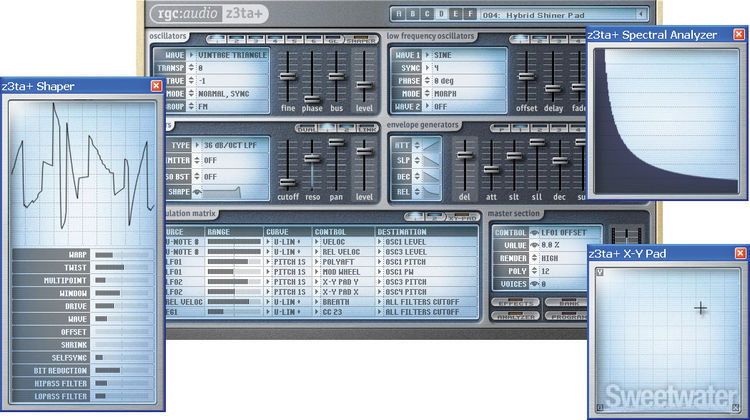| Author
|
Complexity of modulation matrix - pro and contra
|
moki
IsraTrance Junior Member

Started Topics :
38
Posts :
1931
Posted : Jul 27, 2015 20:23:42
|
What is the level of complexity regarding a modulation matrix that you would call healthy?

To start with, here you see z3ta+ with a comprehensible (but not too simple) matrix. There are infinite possibilities to combine the source and destination parameters - from LFOs, evelopes, oscillators into filter cutoffs and resonance or into delays or pulse width or EQ, as a matter of fact whatever you can think of. Furthermore, the drop down menu of the controls or the curves, or the waveshaper makes it literally possible to reach the impossible.
In the tutorials I have seen so far, the experts usually advice to take 2, max 3 oscillators and not delve too much into complex matrix combinations. To me, it is impossible to create even one path in a track without using at least 4-5 oscillators and cross combining the outcome of the LFOs with these oscillators - this makes a sound interesting at all.
But where is the point to say,"it is too much"? ( for me it is so rarely too much, simply because the more you combine, the more psychedelic behavior you will attract).
And what is the disadvantage of making ot more complex exactly?? Why keep it simple? Is it something that can be argumented in terms of compressors or mastering, or is it just an argument giving more weight to a predictable easier workflow ?
What are your experiences with the modulation matrix? Do you have a referral link with info on tricks in this field?
|

|
|
Grevinsky
IsraTrance Full Member

Started Topics :
75
Posts :
685
Posted : Jul 28, 2015 00:38
|
Just do what you like?.
My sounds vary, depending on the soundpallet i want to make, reaching from very simple to advanced.
But whats important i think is to deliver a good quality of the sounds you make, dont be satisfied with something that just sounds okay. Sometimes complexity can create more diffuse/unclear/undefined souding sounds, thats why some sounds may actually benefit from being simple but thats very much depending from case to case.
Another very important aspect is the time it takes you to make it.
I feel my workflow and direction in the track follows a better pace if i dont get too stuck into the details(at first). I create a the general idea of the track first and then go in to the details when structure is done, in this way workflow and fast synthesis help my creative process.
        . .
http://soundcloud.com/mechanical_species |

|
|
frisbeehead
IsraTrance Junior Member
Started Topics :
10
Posts :
1352
Posted : Jul 28, 2015 21:35
|
Well, it does vary a lot depending on what you want to do. But the modular matrix is a common way of establishing connections between modifiers and destinations which are not hard wired.
Further more, complex patches don't necessarily sound complex. Specially when you introduce recursive modulation to the equation, even for slowly progressing drones or pads, modifiers modulating themselves or other similar stuff.
For programming I think it's wise to develop a taste for relating parameters with more simple concepts. And then program like you're answering questions you ask yourself about the sound on your mind. Like, what is it doing, volume wise? Is it a simple or complex timbre? Steady or moving? How does it move? Does it evolve in a linear or more organic fashion? How long does it take? You get the point.
Another approach is simply experimenting and seeing where it takes you. Specially when trying out new stuff. Exaggerating also plays a big role in coming to terms with devices or things you're not really familiar with yet. Like, making some wacky modulation modulate the pitch instead of another parameter, with full amount, can probably make you understand what's going on much faster and then you can rearrange the patch to your taste. At least that's one way to skip endless arbitrary tweaking and really getting to know some instrument or modules or whatever.
As for using many oscillators, it's fine, that's why they're there. Cheers |

|
|
moki
IsraTrance Junior Member

Started Topics :
38
Posts :
1931
Posted : Jul 29, 2015 21:16
|
Just a mind experiment:
Imagine you were deaf and you open the modulation matrix module. Would there be a place, a parameter, a value that you could check to prove if the sound has a "good quality" - anything generally accepted by music experts? Is there an objective measurement for good quality of synthesized sound? Or simply anything goes? Anything that you personally find good?
I am aware of the advantages of clean qualitative sound. But with the help of the modulation matrix the sound starts to evolve very organic, very nonlinear, and as a a matter of fact very " psychedelic", the way that I understand this word. It starts to move ahead on its own. Even if I start with simple linear tones, then add some oscilators, so that every output becomes the dynamic input vor another paramater, which is in turn modulated and becomes the input of another one....So at the end everything is very dynamic, like in a chaotic system, without literally expressions, just a chaotic system at its best. This is what I like, but of course I have notices many times that it is not easy to keep it clean, to keep the sound clear. So what to do? How to avoid noise? How to extract bad unnecessary noise from "noised oscillators"?
And btw, if I stop z3ta, and start with lets say absynth, it is true that the presets of absynth are already very freaky and "psychedelic" without even touching the oscillators, but the point is that they do not always delelop plastically and dynamically on its own, like it would be the case with a proper modulation matrix.
|

|
|
daark
IsraTrance Full Member

Started Topics :
58
Posts :
1397
Posted : Jul 29, 2015 22:04
|
It is usualy not enough. Depends on what you want to achieve. Just keep it in control maybe you'll want to draw some stuff with automation instead to have full control. Mostly really complex and accurate synthesis gives you the best results in terms of "quality". So basicaly to sit a whole day on a patch can give the best result. When you rush things it's harder to fix it later so better perfect your sound at start. I bet the patch that comes out will be worth it.
        http://soundcloud.com/magimix-1/chilling-forest-whispers http://soundcloud.com/magimix-1/chilling-forest-whispers
Wierd shit happens :) |

|
|
daark
IsraTrance Full Member

Started Topics :
58
Posts :
1397
Posted : Jul 29, 2015 22:13
|
Also most presets are for impression to demonstrate the power of the synth so they are very overprocessed. So mainly you should aim on building the timbre of the sound and the volume env . Those are the modulations. And of course to eliminate all the rubbish the synth adds. I would recommend to build a 909bass or something simple with superb quality for practice.
        http://soundcloud.com/magimix-1/chilling-forest-whispers http://soundcloud.com/magimix-1/chilling-forest-whispers
Wierd shit happens :) |

|
|
moki
IsraTrance Junior Member

Started Topics :
38
Posts :
1931
Posted : Jul 30, 2015 01:10
|
|
|